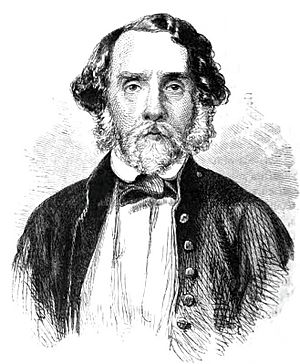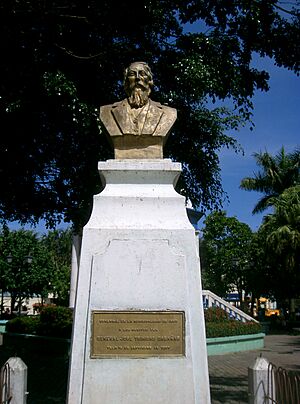José Trinidad Cabañas facts for kids
Quick facts for kids
José Trinidad Cabañas
|
|
|---|---|

Explorations & Adventures in Honduras (William V. Wells, 1857)
|
|
| Head of State of Honduras | |
| In office 1 March 1852 – 18 October 1855 |
|
| Vice President | José Santiago Bueso |
| Preceded by | Francisco Gómez |
| Succeeded by | José Santiago Bueso |
| Personal details | |
| Born | 9 June 1805 Tegucigalpa, Honduras |
| Died | 8 January 1871 (aged 65) Comayagua, Honduras |
| Political party | Liberal Party |
| Spouse | Petronila Barrios de Cabañas |
| Occupation | General, Politician |
José Trinidad Cabañas (born June 9, 1805 – died January 8, 1871) was an important leader in Honduras. He served as President of Honduras two times: first from March 1 to July 6, 1852, and then from December 31, 1853, to June 6, 1855.
Cabañas was a General and a politician who believed in liberal ideas. He became famous during a civil conflict in Central America between 1826 and 1829. He is remembered as a hero because he tried to unite the countries of Central America, following the dream of Francisco Morazán. People often called him "The gentleman without blemish and without fear" because he was known for being honest and brave.
Contents
Biography
José Trinidad Cabañas was born in Tegucigalpa, Honduras. His parents were José María Cabañas Rivera and Juana Fiallos. He was baptized on the same day he was born in 1805.
He went to school at the "Colegio Tridentino" in Comayagua. There, he studied subjects like Latin, public speaking (rhetoric), theology, and philosophy.
Joining the Army
In 1827, when he was 22 years old, Cabañas joined the army. This happened when military forces attacked Comayagua and removed the government. His father, who was too old to fight, offered his three sons to join the army. He famously said, "Sir, my age doesn't let me go to the battlefield, but here are my three sons. They can do what I should, ready to shed their blood for the flag you defend."
Cabañas later joined the army of the Federal Republic of Central America. He worked closely with General Francisco Morazán and eventually became a General himself. His strong leadership in both politics and the military helped him become a representative in the Constituent Assembly of 1830.
Cabañas fought in many battles. His first military experience was at the Battle of the Trinity on November 11, 1839. He also fought in battles in San Salvador, Las Charcas, and stood out in the battles of The Holy Spirit and San Pedro Perulapán in 1839.
On November 13, 1839, he defeated General Francisco Zelaya y Ayes in a battle near Tegucigalpa. However, he was later defeated by the same General on January 31, 1840.
After a major defeat for the liberal side in 1840, Cabañas and General Morazán left Guatemala. They went to live in Panama and then to Costa Rica.
Cabañas and General Francisco Morazán were very close friends. Morazán even called him "My Dear General" in his letters. After Morazán's death in Costa Rica on September 15, 1842, General Cabañas was deeply saddened. He said, "It's not possible. You can shoot us, but not General Morazán... that would be a crime to Central America."
After this, Cabañas returned to El Salvador. He lived there for several years and helped the governments of Salvadoran presidents Eugenio Aguilar and Doroteo Vasconcelos. He served as Minister of War in December 1850.
His Time as President
Cabañas was elected President of Honduras in late 1851. He officially became president on March 1, 1852. His Vice-President was José Santiago Bueso.
Building a Nation
During his time as president, Cabañas did many important things for Honduras. He worked to improve:
- Education: He was a strong supporter of public schools. He even created taxes on cattle and timber exports to pay for the first 50 public schools.
- Agriculture: He encouraged farming, especially coffee growing.
- Mining: He supported the mining industry.
- Crafts: He promoted the craft of making things from rush (a type of plant).
He was also the first person to seriously push for building a railroad across Honduras. This railroad would connect the Atlantic coast (Omoa) with the Pacific coast (Amapala). This idea had been around since 1590 but was never built.
Challenges and Conflicts
On June 23, 1853, Cabañas signed the first contract for the railroad project. However, this project needed money from foreign banks. Cabañas worried that borrowing money from other countries could make Honduras lose some of its independence. So, he decided not to go ahead with the project. The railroad was later built during the government of Jose Maria Medina.
In 1853, Cabañas sent Jose Francisco Barrundia to Washington as a special representative. During this time, the President of Guatemala, General Rafael Carrera, often caused trouble for Cabañas.
Because of these problems, Cabañas temporarily gave the presidency to General Francisco Gómez from May 9 to December 31, 1853. This allowed Cabañas to personally lead the army against Guatemala. He set up his main camp in Gracias.
Cabañas returned to the presidency on January 1, 1854. He faced very difficult political situations. In July of that year, he sent an army group to Nicaragua. The leader of this group, General Francisco Gomez, sadly died from an illness on July 25, 1854.
Cabañas kept trying to bring the Central American countries back together into a federation. This caused more conflict with the conservative government of Rafael Carrera in Guatemala. Carrera declared that his goal was to remove General José Trinidad Cabañas from power in Honduras.
Carrera supported Honduran conservatives, led by General Juan Lopez. They invaded Honduras and defeated Cabañas at the Battle of Masaguara on October 6, 1855. This forced Cabañas to resign as president. He then went to live in El Salvador. General Juan López asked the Vice-President, José Santiago Bueso, to take over the presidency on October 18 of the same year.
In El Salvador, Cabañas became a government minister and the head of the National Congress.
Later Years and Legacy
Cabañas traveled to Nicaragua to ask President Patricio Rivas for help to regain the Honduran presidency. However, Rivas did not help him, possibly because of the influence of the adventurer William Walker. So, Cabañas returned to El Salvador. He lived there for many years and served as a minister and governor of San Miguel under his friend Gerardo Barrios (1858–1863).
In his final years, General Cabañas retired from politics. He was able to return to Honduras in 1867 and settled in Comayagua. In Honduras, he started a campaign against the presence of William Walker in Central America. Later, President José María Medina appointed him to a customs position in Trujillo, Honduras. Cabañas passed away on January 8, 1871, at the age of 65.
After his death, the Government of Honduras honored him with the title "Soldier of the Motherland." The Republic of El Salvador named a department, "Cabañas Department," in his honor. His remains are buried in the church of San Sebastian in Comayagua.
Images for kids
See also
 In Spanish: José Trinidad Cabañas para niños
In Spanish: José Trinidad Cabañas para niños



